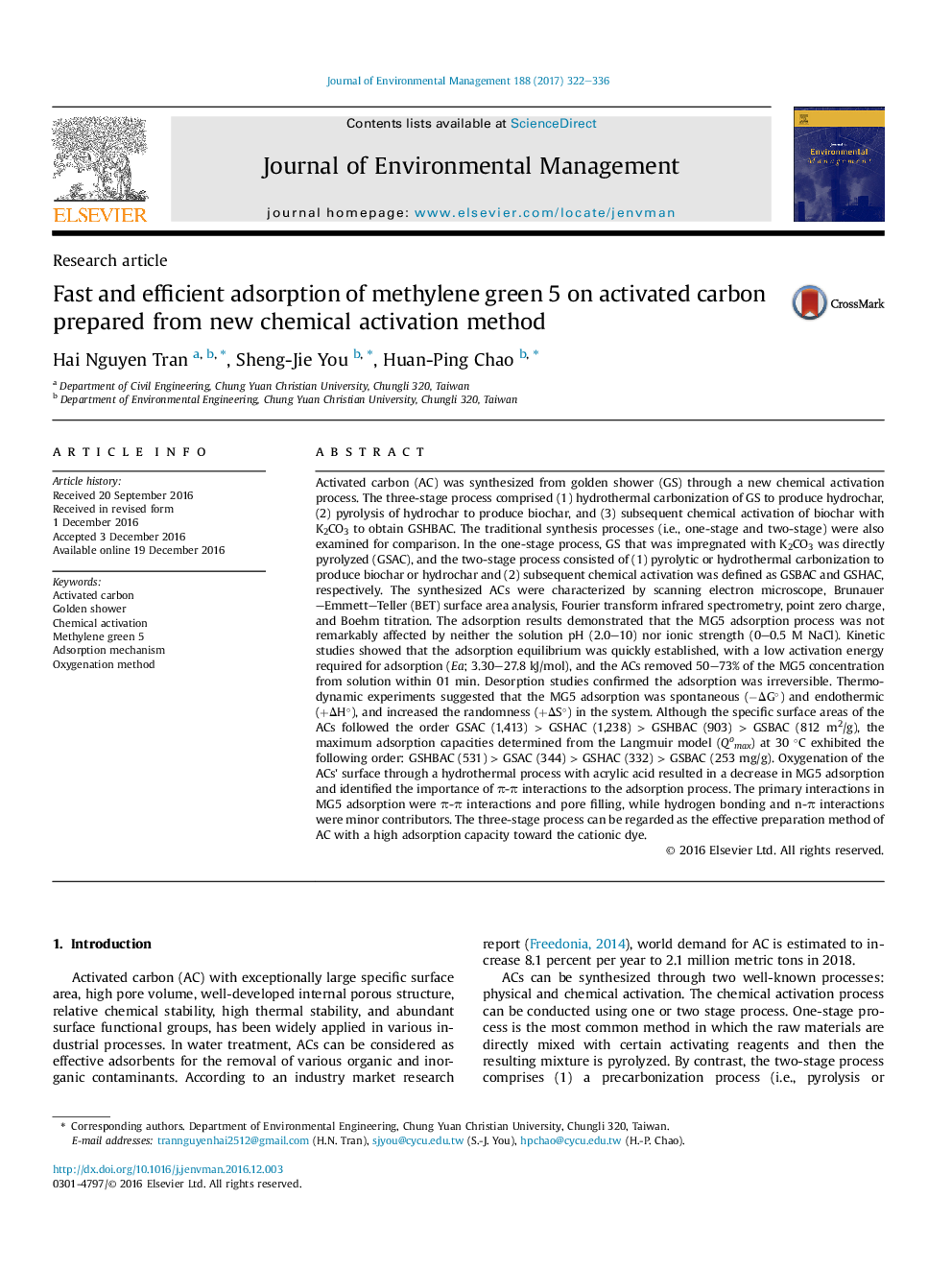| کد مقاله | کد نشریه | سال انتشار | مقاله انگلیسی | نسخه تمام متن |
|---|---|---|---|---|
| 5117149 | 1485227 | 2017 | 15 صفحه PDF | دانلود رایگان |
- Activated carbon synthesized from golden shower through a new chemical activation method.
- A removal rate of 50%-73% achieved within 1Â min in kinetic study.
- Maximum adsorption capacity at 30 °C (531 mg/g), 40 °C (614 mg/g), and 50 °C (678 mg/g).
- Primary adsorption mechanisms: Ï-Ï interaction and non-micropore filling.
- The Ï-Ï interaction identified by a new oxygenation method using acrylic acid.
Activated carbon (AC) was synthesized from golden shower (GS) through a new chemical activation process. The three-stage process comprised (1) hydrothermal carbonization of GS to produce hydrochar, (2) pyrolysis of hydrochar to produce biochar, and (3) subsequent chemical activation of biochar with K2CO3 to obtain GSHBAC. The traditional synthesis processes (i.e., one-stage and two-stage) were also examined for comparison. In the one-stage process, GS that was impregnated with K2CO3 was directly pyrolyzed (GSAC), and the two-stage process consisted of (1) pyrolytic or hydrothermal carbonization to produce biochar or hydrochar and (2) subsequent chemical activation was defined as GSBAC and GSHAC, respectively. The synthesized ACs were characterized by scanning electron microscope, Brunauer-Emmett-Teller (BET) surface area analysis, Fourier transform infrared spectrometry, point zero charge, and Boehm titration. The adsorption results demonstrated that the MG5 adsorption process was not remarkably affected by neither the solution pH (2.0-10) nor ionic strength (0-0.5 M NaCl). Kinetic studies showed that the adsorption equilibrium was quickly established, with a low activation energy required for adsorption (Ea; 3.30-27.8 kJ/mol), and the ACs removed 50-73% of the MG5 concentration from solution within 01 min. Desorption studies confirmed the adsorption was irreversible. Thermodynamic experiments suggested that the MG5 adsorption was spontaneous (âÎG°) and endothermic (+ÎH°), and increased the randomness (+ÎS°) in the system. Although the specific surface areas of the ACs followed the order GSAC (1,413) > GSHAC (1,238) > GSHBAC (903) > GSBAC (812 m2/g), the maximum adsorption capacities determined from the Langmuir model (Qomax) at 30 °C exhibited the following order: GSHBAC (531) > GSAC (344) > GSHAC (332) > GSBAC (253 mg/g). Oxygenation of the ACs' surface through a hydrothermal process with acrylic acid resulted in a decrease in MG5 adsorption and identified the importance of Ï-Ï interactions to the adsorption process. The primary interactions in MG5 adsorption were Ï-Ï interactions and pore filling, while hydrogen bonding and n-Ï interactions were minor contributors. The three-stage process can be regarded as the effective preparation method of AC with a high adsorption capacity toward the cationic dye.
293
Journal: Journal of Environmental Management - Volume 188, 1 March 2017, Pages 322-336
